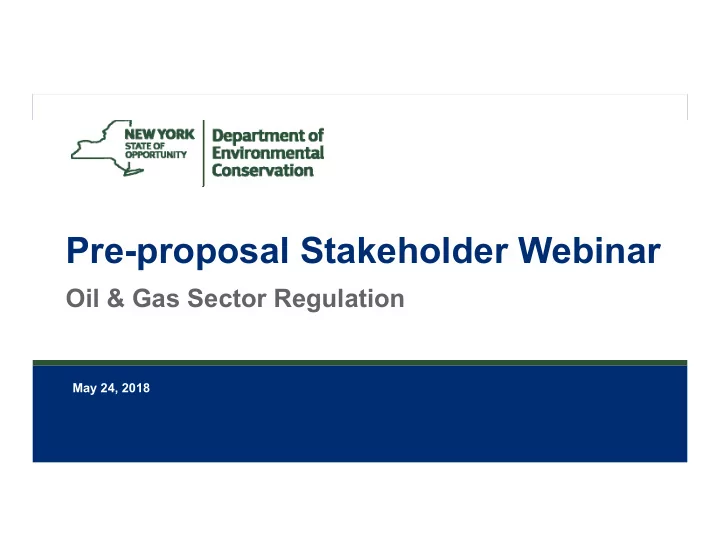

1 Pre-proposal Stakeholder Webinar Oil & Gas Sector Regulation May 24, 2018
2 Today’s presentation • Who is impacted • Control Technique Guideline & Methane Reduction Plan • Pre-proposal status • Segments & Requirements • Additional New York Strategies • Questions
3 Who does this impact? • The regulated oil and natural gas community • Stakeholders and communities who are interested in oil and natural gas regulation Source: http://www.dec.ny.gov/gis/maw/
4 EIA Pipelines • Pipeline map from the U.S. Energy Information Administration (EIA) • Shows the pipelines where associated and regulated equipment may be located
5 Two Pollutants • Volatile Organic Compounds (VOCs) � VOCs include air toxics � VOCs mix with NOx in the atmosphere to form ozone • Methane � potent greenhouse gas � VOC, but exempt by EPA (40CFR 51.100)
6 Types of Regulations – Federal Level New Source Performance Standards (NSPS) • Section 111 of the Clean Air Act • Applies to new sources only Control Technique Guidelines (CTG) - Section 183(e) CAA • Applies to existing sources • VOCs only • Applies only to states with non-attainment areas or that are in the Ozone Transport Region CAA Section 111(d) • Applies to existing sources • Pollutants which are not VOCs
7 New Sources – Oil & Natural Gas • Limits volatile organic compound (VOC) and methane emissions • EPA is reconsidering certain requirements of the methane regulation
8 Existing Sources - Oil & Natural Gas Volatile Organic Compounds (VOCs) Reasonably Available Control Technology (RACT) EPA published “Control Techniques Guidelines (CTG) for the Oil and Natural Gas Industry” in October of 2016. CAA section 182(b)(2) gives states two years after the issuance of a CTG to put in place State Implementation Plan (SIP) revisions to address RACT for sources covered by that new CTG. March 9, 2018: EPA proposed to withdraw the CTG (comments due April 23, 2018). Methane EPA abandoned the development of existing source regulations required under section 111(d).
9 Pre-proposal status • The Department is currently not in the formal rulemaking process under the State Administrative Procedures Act (SAPA) • The Department is accepting comments and feedback from stakeholders during this time which will be part of the public record • This opportunity gives stakeholders a possible mechanism to help shape the future proposal • After a rule is proposed there will be another opportunity to comment in accordance with the SAPA process
10 Production • Drilling and Well Completion • Producing Wells Processing • Gathering Lines • Gas Processing Plant • Gathering and Boosting Compressors Natural Gas Transmission & Storage • Transmission Compressor Stations • Transmission Pipeline • Underground Storage Distribution • Distribution Mains • City Gate • Customer (Adapted from American Gas Association and EPA Natural Gas STAR Program)
11 Oil & Natural Gas: Published CTG Emission Source RACT Recommendation Storage Vessels 95% Reduction from vessels with PTE > 6 tpy Pneumatic Controllers Zero at NG plants, < 6 scfh elsewhere Pneumatic Pumps Zero at NG plants, 95% reduction (if existing control) elsewhere Reciprocating Compressors Replace rod packing after 26,000 hrs or route emissions under a closed negative pressure system Centrifugal Compressors Wet seal 95% reduction or switch to dry seal Equipment Leaks Optical Gas Imaging (OGI) at processing plants Fugitive Emissions OGI at compressors
12 Storage Vessels (production) • 95% reduction of VOC emissions from vessels with a potential to emit (PTE) >6 tons of VOCs per year (tpy)
13 Pneumatic Controllers (Production & Transmission) • Natural gas planned release rate must be less than or equal to 6 standard cubic feet per hour (scfh). • Some exceptions for functional needs including, but not limited to, response time, safety and positive actuation that requires a higher bleed rate.
14 Pneumatic Pumps (Production – well site) • Requires routing of VOC emissions from pump to existing onsite control device/process. • 95% VOC control unless it cannot be achieved. If control cannot be achieved then documentation required. • If pump is in operation for less than 90 days per calendar year the above requirements do not apply.
15 Reciprocating Compressors (Production) • Replace rod packing at least every 26,000 hrs of operation or 36 months. • Alternatively, rod packing emissions may be routed to a closed vent system under negative pressure.
16 Centrifugal Compressors (Production) • Reduce VOC emissions from each centrifugal compressor wet seal fluid gassing system by 95% of its potential to emit (PTE). • Alternatively, switch to dry seal.
17 Leaks (production) • Semiannual optical gas imaging (OGI) monitoring and repair plan covering fugitive emissions components at well sites. • Quarterly OGI monitoring and repair plan at gathering and boosting stations. • EPA Method 21 may be used in place of OGI.
18 New York’s Focus on Air Quality • Methane Reduction Plan Reduce infrastructure emissions • Monitoring & reporting • • Ozone non-attainment VOC emissions reductions •
19 What will be proposed? • The requirements listed in the previous slides are guidelines from EPA for minimum controls (i.e. the CTG). • DEC plans to address methane in addition to VOCs. • DEC seeks input on whether the CTG requirements are adequate: � Additional sources? � More stringent limits? � Methane limits? • DEC will research other oil & gas activities
20 New York State Additional Considerations Information request The Department plans to seek additional information from oil and gas facilities. Potential data requested: • Types of equipment • Inventory of equipment • Hours of operation
21 Pre-SAPA Process Opportunity • State Administrative Procedures Act (SAPA) • We are in the pre-SAPA process phase of this regulatory development. • This is an opportunity to provide comment before the SAPA rulemaking begins.
22 Questions?
23 Thank You • Ona Papageorgiou, P.E. • Professional Engineer 1 • ona.papageorgiou@dec.ny.gov • (518) 402-8396 Connect with us: Facebook: www.facebook.com/NYSDEC Twitter: twitter.com/NYSDEC Flickr: www.flickr.com/photos/nysdec
Recommend
More recommend